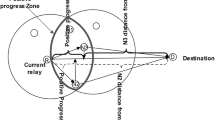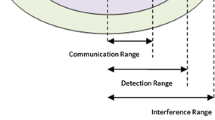Abstract
Vehicular ad hoc network usually operates in various challenging situations like frequent topology changes, high vehicular mobility and the wide range of communication networks. Due to this it is very hard to maintain a higher data rate and also to achieve low latency during data communication. To overcome these problems, given the dynamic natures of all the vehicles in a given network in the proposed routing method, we have defined two fundamental parameters to determine the forwarding vehicle. The first parameter, which we developed, we call it “Channel quality factor (CQF)” or ‘Z’. The other parameter known as “Communication expiration time” or ‘T’ together with CQF is used in the present method to determine the forwarding vehicle. Fuzzy logic is also used to optimize various Quality of Service matrices. This proposed routing method involves two main parts; one is for forwarding Vehicle selection in the road based on the fuzzy logic. The second one is Road selection at the Road Junction to select the right path to reach the signal to the destination vehicle. The simulation results show that our proposed method performs well compare to other well-known protocols (MoZo, BRAVE, OFAODV) in terms of the average end to end delay, packet delivery ratio and control packet overhead, given any number of vehicles in a set of streets. While we are comparing with VEFR protocol, our proposed method shows higher performance in terms of average E2E delay and control packet overhead. However, it is interesting to see that VEFR gives \(\sim \) 5% better result than our proposed method when the number of vehicles in the streets are lower. But in the limit, when the number of vehicles reaches close to \(\sim \) 1900 the difference between the proposed method and method in VEFR goes to zero. At last we compare our proposed method with junction based two V2I protocols. In every cases, it shows better result even though we change the speed of the vehicles, beacon interval, channel data rate and transmission region.




















Similar content being viewed by others
References
Kumar A, Tripathi S, Raw RS (2016) Bringing healthcare to doorstep using VANETs. In: 2016 3rd IEEE-international conference on computing for sustainable global development (INDIACom), New Delhi, pp 2856–2859
Mukherjee S, Gupta DS, Biswas GP (2019) An efficient and batch verifiable conditional privacy-preserving authentication scheme for VANETs using lattice. Computing 101:1763–1788. https://doi.org/10.1007/s00607-018-0689-3
Reshmi TR, Murugan K (2015) Filter-based address autoconfiguration protocol (FAACP) for duplicate address detection and recovery in MANETs. Computing 97:309–331. https://doi.org/10.1007/s00607-014-0417-6
Smiri S et al (2018) Geographic and topology based routing protocols in vehicular ad-hoc networks: performance evaluation and QoS analysis. In: 2018 international conference on intelligent systems and computer vision (ISCV). IEEE
Sudheera KLK, Ma M, Chong PHJ (2019) Link stability based optimized routing framework for software defined vehicular networks. IEEE Trans Veh Technol 68(3):2934–2945. https://doi.org/10.1109/TVT.2019.2895274
Karp B, Kung HT (2000) GPSR: Greedy perimeter stateless routing for wireless networks. In: Proceedings of 6th Annual International Conference Mobile Computing and Networking (MobiCom), New York, NY, USA, pp 243–254. https://doi.org/10.1145/345910.345953
Dubey CP, Kumar V, Sharma B, Kaur G (2018) Shortest path algorithm for distributed VANET using grid computing. In: 2018 international conference on smart systems and inventive technology (ICSSIT). Tirunelveli, India, pp 118–121
Eiza MH, Ni Q (2013) An evolving graph-based reliable routing scheme for VANETs. IEEE Trans Veh Technol 62(4):1493–1504
Jiang R, Zhu Y, He T, Liu Y, Ni LM (2014) Exploiting trajectory-based coverage for geocast in vehicular networks. IEEE Trans Parallel Distrib Syst 25(12):3177–3189
Alzamzami O, Mahgoub I (2016) An enhanced directional greedy forwarding for VANETs using link quality estimation. In: Proceedings of IEEE wireless communications and networking conference, pp 1–7
Cai X, He Y, Zhao C, Zhu L, Li C (2014) LSGO: link state aware geographic opportunistic routing protocol for VANETs. EURASIP J Wirel Commun Netw 2014, 96. https://doi.org/10.1186/1687-1499-2014-96
Wu C, Ohzahata S, Kato T (2013) Flexible, portable, and practicablesolution for routing in VANETs: a fuzzy constraint Q-learningapproach. IEEE Trans Veh Technol 62(9):4251–4263
Senouci O, Harous S, Aliouat Z (2019) A new heuristic clustering algorithm based on RSU for internet of vehicles. Arab J Sci Eng 44:9735–9753. https://doi.org/10.1007/s13369-019-03854-
Aravindhan K, Dhas CSG (2019) Destination-aware context-based routing protocol with hybrid soft computing cluster algorithm for VANET. Soft Comput 23:2499–2507. https://doi.org/10.1007/s00500-018-03685-7
Patil A, Shet NSV (2019) Improving download throughput by saving the transmission bandwidth in vehicular networks. Arab J Sci Eng 44:3967–3976. https://doi.org/10.1007/s13369-019-03762-5
Purkait R, Tripathi S (2019) Fuzzy logic based multi-criteria intelligent forward routing in VANET. Wirel Pers Commun. https://doi.org/10.1007/s11277-019-06962-2
Wu C et al (2015) Toward practical and intelligent routing in vehicular ad hoc networks. IEEE Trans Veh Technol 64.12:5503–5519
Wu C et al (2018) Computational intelligence inspired data delivery for vehicle-to-roadside communications. IEEE Trans Veh Technol 67.12:12038–12048
Lochert C, Hartenstein H, Tian J, Fussler H, Hermann D, Mauve M (2003) A routing strategy for vehicular ad hoc networks in city environments. In: Proceedings of the IEEE intelligent vehicles symposium, pp 156–161
Lochert C, Mauve M, Füßler H, Hartenstein H (2005) Geographic routing in city scenarios. ACM SIGMOBILE Mob Comput Commun Rev 9(1):69–72. https://doi.org/10.1145/1055959.1055970
Naumov V, Gross TR (2007) Connectivity-aware routing (CAR) invehicular ad-hoc networks. In: Proceeding of 26th IEEE international conference computer and communications (INFOCOM), pp 1919–1927
Jerbi M, Senouci SM, Rasheed T, Ghamri-Doudane Y (2009) Towards efficient geographic routing in urban vehicular networks. IEEE Trans Veh Technol 58(9):5048–5059
Debnath A, Basumatary H, Tarafdar A, Debbarma MK, Bhattacharyya BK (2019) Center of mass and junction based data routing method to increase the QoS in VANET. AEU Int J Electron Commun 108:36–44
Togou MA, Hafid A, Khoukhi L (2016) SCRP: stable CDS-based routing protocol for urban vehicular ad hoc networks. IEEE Trans Intell Transp Syst 17(5):1298–1307
Liu K, Ng JKY, Lee V, Son SH, Stojmenovic Ivan (2016) Cooperative data scheduling in hybrid vehicular ad hoc networks: VANET as a software defined network. IEEE/ACM Trans Netw: TON 24(3):1759–1773
Chen C, Liu L, Qiu T, Wu DO, Ren Z (2019) Delay-aware grid-based geographic routing in urban VANETs: a backbone approach. IEEE/ACM Trans Netw 27(6):2324–2337
Liu K, Ng JKY, Lee VCS, Son SH, Stojmenovic I (2016) Cooperative data scheduling in hybrid vehicular ad hoc networks: VANET as a software defined network. IEEE/ACM Trans Netw 24(3):1759–1773
Lin D, Kang J, Squicciarini A, Wu Y, Gurung S, Tonguz O (2017) MoZo: a moving zone based routing protocol using pure V2V communication in VANETs. IEEE Trans Mob Comput 16(5):1357–1370
Havens TC, Anderson DT, Wagner C (2015) Data-informed fuzzy measures for fuzzy integration of intervals and fuzzy numbers. IEEE Trans Fuzzy Syst 23(5):1861–1875
Abbas NI, Ilkan M, Ozen E (2015) Fuzzy approach to improving route stability of the AODV routing protocol. J Wirel Commun Netw 2015:235. https://doi.org/10.1186/s13638-015-0464
Wu C, Yoshinaga T, Chen X, Zhang L, Ji Y (2018) Cluster-based content distribution integrating LTE and IEEE 802.11p with fuzzy logicand Q-learning. IEEE Comput Intell Mag 13(1):41–50
Ghasemnezhad S, Ghaffari A (2018) Fuzzy logic based reliable and real-time routing protocol for mobile ad hoc networks. Wirel Pers Commun 98:593–611. https://doi.org/10.1007/s11277-017-4885-9
Wu J, Fang M, Li H, Li X (2020) RSU-Assisted traffic-aware routing based on reinforcement learning for urban vanets. IEEE Access 8:5733–5748. https://doi.org/10.1109/ACCESS.2020.2963850
Bouazzi Imen, Bhar Jamila, Atri Mohamed (2017) Priority-based queuing and transmission rate management using a fuzzy logic controller in WSNs. ICT Express 3(2):101–105
Rahnamaei Yahiabadi S, Barekatain B, Raahemifar K (2019) TIHOO: an enhanced hybrid routing protocol in vehicular ad-hoc networks. J Wirel Commun Netw 2019:192. https://doi.org/10.1186/s13638-019-1503-4
Fahad TO, Ali AA (2018) Multiobjective optimised routing protocol for VANETs. Adv Fuzzy Syst 2018:7210253. https://doi.org/10.1155/2018/7210253
Hawbani E, Torbosh W, Xingfu P, Sincak L, Zhao Al-Dubai AY (2019) Fuzzy based distributed protocol for vehicle to vehicle communication. IEEE Trans Fuzzy Syst. https://doi.org/10.1109/TFUZZ.2019.2957254.2019
Saleet H, Basir O, Langar R, Boutaba R (2010) Region-based location-service-management protocol for VANETs. IEEE Trans Veh Technol 59(2):917–931. https://doi.org/10.1109/TVT.2009.2033079
Saleet H, Basir O (2007) Location-based message aggregation in vehicular ad hoc networks. IEEE Globecom Workshops, Washington, DC, pp 1–7
Mamdani EH (1977) Application of fuzzy logic to approximate reasoningusing linguistic synthesis. IEEE Trans Comput C–26(12):1182–1191
The Network Simulator: ns2 [Online]. http://www.isi.edu/nsnam/ns/. Accessed 23 Feb 2020
Ruiz PM, Cabrera V, Martinez JA, Ros FJ (2010) BRAVE: Beacon-less routing algorithm for vehicular environments. In: The 7th IEEE international conference on mobile ad-hoc and sensor systems (IEEE MASS 2010), San Francisco, CA, 2010, pp 709–714
Yang L, Liu H (2016) A data transmitting scheme based on improved AODV and RSU-assisted forwarding for large-scale VANET. Wirel Pers Commun 91:1489–1505. https://doi.org/10.1007/s11277-016-3542-z
Srivastava A, Prakash A, Tripathi R (2020) An adaptive intersection selection mechanism using ant Colony optimization for efficient data dissemination in urban VANET. Peer Peer Netw Appl 13:1375–1393. https://doi.org/10.1007/s12083-020-00892-8
Acknowledgements
This work is done at the “Center of Innovation” at NIT Agartala, India. One of the author Dr. Bidyut K. Bhattacharyya is the founder of this innovation center.
Author information
Authors and Affiliations
Corresponding author
Additional information
Publisher's Note
Springer Nature remains neutral with regard to jurisdictional claims in published maps and institutional affiliations.
Rights and permissions
About this article
Cite this article
Debnath, A., Basumatary, H., Dhar, M. et al. Fuzzy logic-based VANET routing method to increase the QoS by considering the dynamic nature of vehicles. Computing 103, 1391–1415 (2021). https://doi.org/10.1007/s00607-020-00890-x
Received:
Accepted:
Published:
Issue Date:
DOI: https://doi.org/10.1007/s00607-020-00890-x




